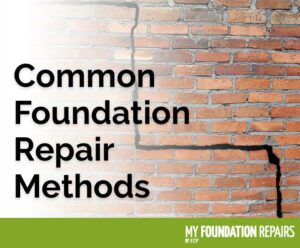Common Foundation Repair Methods
It’s never any fun to learn that your home’s foundation is in need of repair, but unfortunately, this is the kind of maintenance that is mandatory, not optional. However, you do have options that can differ quite a bit with regard to price, depending on how extensive the foundation damage is.
Your property’s soil conditions tend to be at the root of the problem, both shifting and expansive clay soils create foundation problems for all kinds of home foundations – from slab foundations and crawl spaces to full basements.

Furthermore, here are the two most common types of foundation problems:
- Settlement: when a foundation or portions of a foundation sink below the original grade
- Upheaval: when a foundation or portions of a foundation raise above the original grade
The process of evaluating your property should involve an assessment of where the moisture is coming from, whether there is proper drainage pointed away from your property and into more garden or irrigation-heavy areas, and what kind of foundation damage is taking place (merely cosmetic or more structural-level movement)?
Depending on the factors involved, structural engineers or foundation repair experts will likely recommend a few different options available to you. Here is a list of different foundation repair methods that offer varying degrees of stabilization and support.
Masonry Patches & Sealants
This is one of the most DIY-friendly foundation repair methods, but admittedly best-suited for foundations with a few trouble spots, rather than major issues. Masonry patches and sealants are usually available at your local hardware store.
Concrete patches typically have drying times under 24 hours, and they utilize strong adhesive properties such as hydraulic cement, vinyl concrete, epoxies, silicone, or polyurethane. Select a patch using a mixture appropriate to the severity of the crack to best reinforce your concrete foundation. It is important to be aware that these types of solutions can often mask the symptoms of a problem and not necessarily eliminate the source of the problem itself.
Slab Jacking
Also referred to as “mud jacking,” this is a common repair method for foundation concrete that is sinking. To avoid replacing your concrete, the process involves drilling strategically placed 2” holes in the foundation into sunken spaces below, then using small hoses to inject a mixture of grout or foam beneath the foundation.
This process will help the foundation to rise within a few hours. Since it’s an alternative to installing a brand new concrete foundation, it’s possible to save thousands of dollars as well as a great deal of time, by going this route.
Spot Piers
This can be a great method for light-loaded areas like porches or attached patios. Spot piers are installed by digging around the foundation and inserting concrete to help stabilize damaged areas of your home’s foundation.
Segmented Piers
A bit larger than spot piers, segmented piers are cylindrical tubes of concrete that can be pressed into the soil beneath your foundation. One advantage to these types of piers is that they are relatively affordable, so you can save quite a bit by opting for this method.
High-Density Polyurethane Foam
Widely available, high-density polyurethane foam is a great option for unexpected or emergency foundation problems. It also rises quickly, so it’s an excellent choice for residential concrete or time sensitive repairs.
Be sure to use the foam that’s best for your particular situation and climate. For example, there are foams designed for high-moisture soils or water-exposure, while others are designed for stabilization.
Helical Piers
Helical piers, also known as anchors, are steel beams that contain helices (helix-shaped designs), which allow the beams to reach deep into soil in order to stabilize the foundation of your home. These types of piers are known for working well with soft or damp soils—on the coast, for example.
Concrete Piers
Often recommended for more warm or mild climates, concrete piers are placed deep underground and are custom-built to match your soil and the foundation’s depth.
Steel Piers
Another very long-lasting foundation repair option is steel piers, which are considered especially effective for reinforcing homes that have settled or sloped at an uneven angle. Steel can last up to 150 years, in fact, and they work well for reinforcing heavier structures, as well.
While Pier installation can be quite expensive, it is also considered one of the most durable and long-lasting foundations available, so you can rest assured that your home will be well-supported for many years to come.
We’d be happy to help ensure your home will be in good shape and well-prepared for any inclement weather or soil shifting that may come your way. If you’re looking for reliable professionals to help repair a damaged foundation, contact us for a free estimate.
